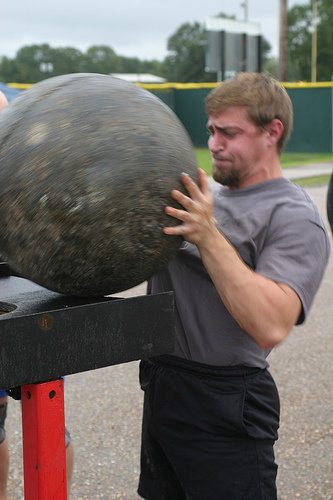Archive
Drop sets are as old as the barbell but they work. Here’s a new and brutal way to perform this classic technique. …read more
Regular paused squats are tough, but breathing paused squats take the pain – and the results – to the next level. …read more

- Part 1
- Part 2
Now I wouldn’t be spewing so much pullup venom for no reason. I actually enjoy kipping pullups. I’m just very much interested in learning why kipping pullups cause injury so that we can learn how to make this exercise safer. If you’re a competitive crossfitter or coach then you’re most likely interested as well. So without further ado, 6 ways to make kipping pullups safer.
1. Build strength slowly
I love pullups, they’re a phenomenal exercise. It used to be extremely impressive when you saw someone bang out 20 strict dead hang pullups. Back in my personal training days I’d rejoice when I had a long time client finally completed their first pullup. Now with the advent of crossfit you’ll regularly see workouts with 50+ pullups to be completed in a matter of minutes. With these workouts comes the necessity of getting better at pullups, and FAST! Enter the advent on kipping pullups, a way to complete more pullups in less time and finish those workouts faster.
However, because of the kipping action we may have skipped a step in the stages of learning how to do pullups properly. We might be missing out on a key pillar, strength.
As we discussed in the first article, there are several reasons why performing kipping pullups before building prerequisite strength is bad. If someone does not have the prerequisite strength to control the descent of their body from a pullup with bodyweight, then jumping into a kip may be inviting injury.
My favorite fix? Good old strength work.
Strength work can …read more
The Z Press is much harder than the overhead press and it will quickly expose any weaknesses you might have. …read more
Pulling big weights requires getting strong in a lot of supporting muscles, starting with the upper and mid back. …read more
Building menacing forearms and developing a bar-bending grip require two unique approaches. Here’s how to get both. …read more
Compression wrapping is an inexpensive way to treat those troublesome knees, wrists, and elbows. Here’s how to do it. …read more

All in all I felt the programming was solid but I enjoyed some parts and saw room for improvement in others.
Things I didn’t like:
- The high volume weeks were too much.
- I have trouble improving my squat and deadlift without max effort work. This go around will have more max effort work as well as a separate squat day without oly lifts first.
- I want to make the rep ranges on accessory exercises larger. This way you can more easily modify to fit your own needs.
- I wanted to make the weights used more percentage based and rep max based to make the program easier to modify
- There was a bit too much lifting prior to met-con for me. I’d feel really beat during any conditioning. This month includes more met-con with less strength work prior.
- I don’t think I had enough met-con work into the past month’s program in general.
Things I liked:
- I liked the amount of oly lifting. This is a weakness for me and I’ve been able to improve over the past month.
- The shoulder volume was manageable. My shoulders have been feeling great.
- I really like the skill/conditioning work with minimal rest. I feel this is a good way to do accessory work so that technique can be maximized while still being relatively fatigued.
A few additional pointers:
- Make sure you’re eating enough calories throughout the program, it’s not an easy one.
- Workouts should take 60-90 minutes. If they’re taking longer then that then I would start modifying things to finish faster.
- You …read more

1. You Aren’t Mobile Enough
I’ve been hatin on mobility quite a bit lately, but not because I don’t think it’s important, just overemphasized. Based on research we know that a tight pec minor can place us into anterior tilt of the scapula (1). This decreases subacromial space and puts us at risk for subacromial impingement and rotator cuff damage(1). Having a tight posterior shoulder can do the same (Good old GIRD)(1). Decreased thoracic spine mobility can decrease scapular posterior tilt and upward rotation, two motions that are critical for shoulder health(1).
NERD ALERT: Go ahead, learn some more about shoulder impingement and scapular kinematics, you know you want to.
Another thing to keep in mind is that forcing yourself into a position that your body can’t achieve normally because of poor flexibility will really stress the shoulder. Essentially, if you can’t put your arms overhead fully unweighted, then it’s going to be one heck of a stretch when you start hanging from a bar. Add some kipping pullups to the equation and we might be running into trouble. You can assess your own overhead mobility. I’ve been meaning to make a better video assessment but this will have to do for now. On top of that, lacking mobility in the shoulder can cause your body to try and gain motion from another joint. I’ve seen several people who have lower back pain from doing kipping pullups and believe …read more



 Location: Östermalmsgatan 13
Location: Östermalmsgatan 13 Phone: +46 (0) 141-478830
Phone: +46 (0) 141-478830 Email:
Email: 





NYA KOMMENTARER
very nice!
posted in Nice & Clean. The best for your blog!from nice
also another nice feedback here, uh uh
posted in Nice & Clean. The best for your blog!from corrado